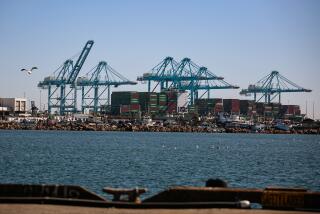From the Workplace to the Poor House
- Share via
Dangerous work is a major contributing factor to poverty in America. Most people assume that workers’ compensation, insurance and lawsuits take care of families when injuries, fatalities or disease strike. The reality is much different.
Families often experience a sharp reduction in income when injury from dangerous work strikes, prematurely ending careers. For example, workers’ compensation supplies at best two-thirds of a worker’s historic (average of the last two years) earnings, and usually provides far less. Meanwhile, benefits such as health insurance may be lost, imposing drastic new expenses on the family.
America needs to understand the scope of this problem and how it came about. Before 1911, a work-related injury or disease was considered the fault of the worker. In the following decade, most state governments passed workers’ compensation programs, a no-fault insurance scheme that covered medical expenses and lost wages when workers were injured.
These programs had a significant unintended consequence: They tended to legitimate worker injury by “taking care of it” with modest compensation payments. In other words, some injury was accepted because compensation, however meager, was available. Employers’ insurance costs could be comfortably predicted and made a part of each year’s budget. Business as usual prevailed.
Workers’ compensation programs were adopted in an era when workplace accidents were widely recognized, but occupational diseases were nearly invisible. Since then, through tragedy after tragedy, we have been reminded that black lung, asbestosis, silicosis, lead poisoning, cancer and other diseases may begin with workplace exposures. But there are many barriers to workers’ compensation for diseases, and it is estimated that less than 10% of serious disease cases are currently compensated. Many deserving workers simply go without.
Even for those who receive workers’ compensation, the payments are likely to be inadequate. In fact, families experiencing the temporary or permanent loss of a breadwinner in the 1980s are probably worse off than those who experienced a comparable loss in the 1970s. Workers’ compensation payments are tied to the victim’s wages, and real wages of middle- income Americans have declined during the last decade. Sixty percent of a machinist’s wage today buys less than 60% of a machinist’s wage 15 years ago. Further, unrealistic caps on compensation--typically ranging between $200-$250 a week--often impose limits that assure absolute poverty for many families.
Moreover, the availability of lawsuits as a remedy has greatly diminished in recent years. Responding to the alleged liability crisis, state legislatures have imposed low wrongful death caps and greater restrictions such as comparative negligence requirements. In many states, lawsuits arising from dangerous workplace incidents have dropped from a trickle to a halt.
The magnitude of this problem is not small. Studies at the Mount Sinai School of Medicine in New York show that as many as 70,000 men and women die of occupational disease each year. According to the National Safety Council, 11,000 men and women die from traumatic workplace accidents each year. Another 70,000 workers are permanently disabled. We believe that 50,000 more individuals will be disabled and off the payrolls for at least six months this year.
Based on demographic patterns, we can estimate that at least half of the total--or at least 100,000--disabled men and women will have dependents, and that the majority of them will suffer a substantial decline in income after losing a breadwinner.
This problem has not come cheap to the public. Congress has partly addressed the problem by tapping Social Security--robbing Peter to pay Paul. Working with government analysts, we estimate that workplace accidents and diseases cost the Social Security Trust Fund $7.65 billion in fiscal 1988. This Band-Aid strategy, while helpful to some workers, simply transfers the costs of dangerous workplaces from employers to taxpayers.
It is terribly wrong for a family that suffers one tragedy to suffer another. Two solutions are needed. First, we need better ways to compensate workers who become injured or ill while on the job. Workers’ compensation must be expanded to cover illnesses, must provide adequate wage replacement and must be streamlined to achieve prompt payments. Other strategies, such as insurance mechanisms, litigation and service programs, must be considered.
A second key element is the prevention of workplace injuries and accidents. As we come to understand the nature and costs of the problem, we must apply this understanding to research, risk assessment and enforcement of strong health and safety standards. By addressing the problem on the front end, we can reduce the contribution of dangerous workplaces to suffering and poverty in America.
More to Read
Inside the business of entertainment
The Wide Shot brings you news, analysis and insights on everything from streaming wars to production — and what it all means for the future.
You may occasionally receive promotional content from the Los Angeles Times.










